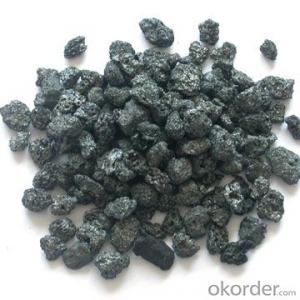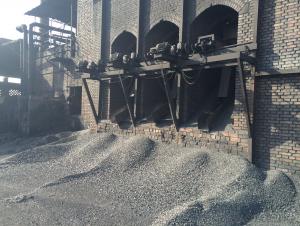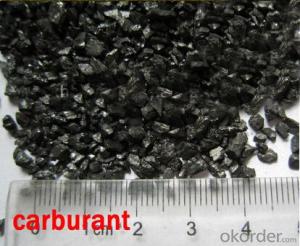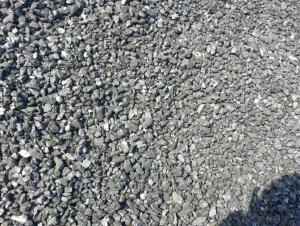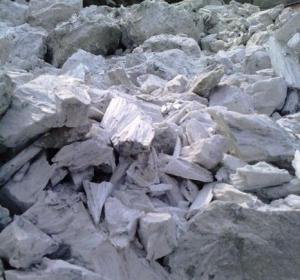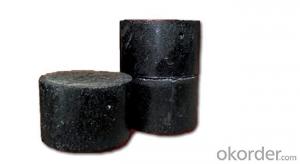Calcined Petroleum Coke with 98.5 Carbon
- Loading Port:
- Tianjin
- Payment Terms:
- TT OR LC
- Min Order Qty:
- 1 m.t.
- Supply Capability:
- 10000000 m.t./month
OKorder Service Pledge
OKorder Financial Service
You Might Also Like
1.Structure of Calcined Petroleum Coke Description
Calcined Petroleum Coke is made from raw petroleum coke,which is calcined in furnace at a high temperature(1200-1300℃).CPC/Calcined Petroleum Coke is widely used in steelmaking,castings manufacture and other metallurgical industry as a kind of recarburizer because of its high fixed carbon content,low sulfur content and high absorb rate.Besides,it is also a best kind of raw materials for producing artifical graphite(GPC/Graphitized Petroleum Coke) under the graphitizing temperature(2800℃).
2.Main Features of the Calcined Petroleum Coke
High-purity graphitized petroleum coke is made from high quality petroleum coke under a temperature of 2,500-3,500°C. As a high-purity carbon material, it has characteristics of high fixed carbon content, low sulfur, low ash, low porosity etc.It can be used as carbon raiser (Recarburizer) to produce high quality steel,cast iron and alloy.It can also be used in plastic and rubber as an additive.
3. Calcined Petroleum Coke Images
4. Calcined Petroleum Coke Specification
| Place of Origin: | China (Mainland) | Type: | Petroleum Coke | Sulphur Content (%): | 0.5 |
| Ash Content (%): | 1 | Fixed Carbon (%): | 98.5 | Moisture (%): | 1 |
| Volatile Matter (%): | 0.5 | Brand Name: | CNBM | Model Number: | 98.5 CPC |
| function: | steel-making and founding as a kind of car |
5.FAQ of Calcined Petroleum Coke
1). Q: Are you a factory or trading company?
A: We are a factory.
2). Q: Where is your factory located? How can I visit there?
A: Our factory is located in ShanXi, HeNan, China. You are warmly welcomed to visit us!
3). Q: How can I get some samples?
A: Please connect me for samples
4). Q: Can the price be cheaper?
A: Of course, you will be offered a good discount for big amount.
- Q:What is carbon nanotechnology?
- Carbon nanotechnology involves the study and manipulation of carbon-based materials at the nanoscale, typically in the form of carbon nanotubes, fullerenes, or graphene. It focuses on harnessing the unique properties and structures of these carbon materials to develop innovative applications in various fields such as electronics, medicine, energy, and materials science.
- Q:What is the carbon footprint?
- The carbon footprint refers to the total amount of greenhouse gases, particularly carbon dioxide (CO2), released into the atmosphere as a result of human activities. It is a measure of the impact individuals, organizations, or countries have on the environment in terms of contributing to climate change. This footprint includes direct emissions from burning fossil fuels for transportation, heating, and electricity, as well as indirect emissions from the production and transport of goods and services we consume. The carbon footprint is usually measured in units of carbon dioxide equivalent (CO2e) and is an important tool for evaluating and managing our environmental impact. By understanding and reducing our carbon footprint, we can mitigate climate change and work towards a more sustainable future.
- Q:What are the impacts of carbon emissions on the stability of mountains?
- Carbon emissions can have various impacts on the stability of mountains. One significant effect is the acceleration of glacial melting, leading to increased water runoff and the potential for more frequent and severe landslides. Additionally, carbon dioxide contributes to the acidification of rainwater, which can corrode rocks and weaken the stability of mountain slopes. Climate change, driven by carbon emissions, also leads to alterations in precipitation patterns, temperature, and weather events, increasing the risk of erosion, rockfalls, and avalanches. Overall, carbon emissions have a detrimental influence on the stability of mountains, posing risks to both human populations and ecosystems.
- Q:What are the limitations of carbon dating?
- One limitation of carbon dating is that it can only be used to date organic materials up to around 50,000 years old. Additionally, the dating method can be affected by contamination or mixing of materials, which can lead to inaccurate results. Furthermore, carbon dating relies on the assumption that the atmospheric concentration of carbon-14 has remained constant over time, which is not always the case. Finally, carbon dating is not suitable for dating objects that do not contain carbon, such as rocks or minerals.
- Q:How does carbon impact the prevalence of floods?
- Flood prevalence is not directly affected by carbon, but its role in influencing climate change is crucial, as it can impact the occurrence and severity of floods. Carbon dioxide (CO2), a greenhouse gas, primarily traps heat in the Earth's atmosphere, resulting in global warming. This global temperature increase has various consequences, including an escalation in extreme weather events like floods. As the Earth warms, the atmosphere can hold more moisture, increasing the likelihood of heavy precipitation events. This leads to more intense rainfall, causing rivers and water bodies to overflow and causing floods. Additionally, warmer temperatures can contribute to the melting of glaciers and ice caps, raising sea levels and intensifying the impact of floods, especially in coastal regions. Moreover, human activities such as burning fossil fuels and deforestation are the primary drivers of climate change, leading to carbon emissions. By reducing our carbon footprint and transitioning to cleaner energy sources, we can help mitigate the effects of climate change and potentially decrease flood prevalence in the long run. It's important to note that although carbon emissions significantly contribute to climate change, floods are not solely caused by them. Other natural factors, such as rainfall patterns, topography, and land use, also have important roles in determining flood risks.
- Q:What is carbon nanocomposite coating?
- Carbon nanocomposite coating is a type of protective coating that is made using carbon nanotubes or other carbon-based nanoparticles. These nanoparticles are dispersed within a matrix material, such as polymer or metal, to create a thin film that can be applied onto various surfaces. The main purpose of carbon nanocomposite coatings is to enhance the mechanical, thermal, and electrical properties of the coated material. The addition of carbon nanoparticles improves the strength, hardness, and wear resistance of the coating, making it more durable and long-lasting. It also provides excellent corrosion resistance, making it suitable for applications in harsh environments. One of the key advantages of carbon nanocomposite coatings is their ability to provide multifunctional properties. For example, they can be engineered to have high electrical conductivity, which makes them ideal for applications in electronics and electrochemical devices. Additionally, they can have high thermal conductivity, making them useful for heat dissipation in electronic devices or as a thermal barrier coating. Moreover, carbon nanocomposite coatings have shown promising results in various fields such as aerospace, automotive, energy, and healthcare. In aerospace, they can be used to improve the performance and durability of aircraft components, while in the automotive industry, they can provide anti-scratch and self-cleaning properties. In energy applications, they can be utilized to enhance the efficiency of solar panels or to prevent corrosion in oil and gas pipelines. Additionally, in healthcare, they can be used for drug delivery, as antibacterial coatings, or for bio-sensing applications. Overall, carbon nanocomposite coatings offer a wide range of benefits, including improved mechanical and electrical properties, corrosion resistance, and multifunctionality. With ongoing research and development, these coatings hold great promise for various industries, providing innovative solutions to address their specific needs and challenges.
- Q:What are the different types of carbon fibers?
- There are several different types of carbon fibers, including standard modulus carbon fiber, intermediate modulus carbon fiber, high modulus carbon fiber, and ultra-high modulus carbon fiber. These types vary in their strength, stiffness, and cost, making them suitable for different applications and industries.
- Q:How does a kebab cook at home?
- Do you have long fire sticks in your house?...... Yes, just a carbon and burn it over the gas stove...... If not, apply a little oil underneath......Burn, put carbon on the top, pay attention to leave the gap, do not suppress it.
- Q:Why use carbon batteries for alarm clocks?
- Look at your clock is what kind of, some nickel battery (batteries) can also be a bit expensive. Lithium battery. And what in fact almost never mind, as long as you start voltage alarm on the line. You said carbon battery is called alkaline battery his standard voltage is 1.5V the charging the battery is generally 1.2V. to this problem is not a reward.
- Q:What are the impacts of carbon emissions on the stability of permafrost?
- Carbon emissions have significant impacts on the stability of permafrost. As carbon dioxide and other greenhouse gases accumulate in the atmosphere, they trap heat, leading to global warming. This rise in temperatures causes permafrost, which consists of permanently frozen soil and rock, to thaw. The thawing of permafrost releases large amounts of carbon dioxide and methane, intensifying the greenhouse effect and further contributing to climate change. Additionally, as permafrost thaws, it destabilizes the ground, resulting in land subsidence, infrastructure damage, and increased erosion. These impacts can have cascading effects on ecosystems, indigenous communities, and the overall stability of the environment.
1. Manufacturer Overview |
|
|---|---|
| Location | |
| Year Established | |
| Annual Output Value | |
| Main Markets | |
| Company Certifications | |
2. Manufacturer Certificates |
|
|---|---|
| a) Certification Name | |
| Range | |
| Reference | |
| Validity Period | |
3. Manufacturer Capability |
|
|---|---|
| a)Trade Capacity | |
| Nearest Port | |
| Export Percentage | |
| No.of Employees in Trade Department | |
| Language Spoken: | |
| b)Factory Information | |
| Factory Size: | |
| No. of Production Lines | |
| Contract Manufacturing | |
| Product Price Range | |
Send your message to us
Calcined Petroleum Coke with 98.5 Carbon
- Loading Port:
- Tianjin
- Payment Terms:
- TT OR LC
- Min Order Qty:
- 1 m.t.
- Supply Capability:
- 10000000 m.t./month
OKorder Service Pledge
OKorder Financial Service
Similar products
New products
Hot products
Hot Searches
Related keywords

